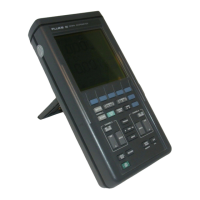CIRCUIT DESCRIPTIONS
3
•
5
•
A multitasking
kernel for hardware and software scheduling
Processing
the acquiree data Is only one of the tasks of the microprocessor.
The ScopeMeter uses
a
multitasking
kernel for hardware and software schedullrig, based on internal
and external Interrupts.
The
microprocessor contains Internal timers, which can
be
programmed
by the software. One of
these timers is used to generate interrupts,
e.g.
to scan the
keypad
for
depressed or released keys,
Except processing (calibrating) the acquired
data,
the microprocessor
also does mathematical
computatlone and controls the hardware. The multitasking
kernel takes care that every 20 ms of
processing time, a task is Interrupted. This task will then
be
held
and
rescheduled,
unless it requires
execution
without Interruption, kn this way a variety of user-requested
tasks can be handled quasi-
si muttaneously,
without the user being aware of the heavy loads on the mioroprocsssor.
The display
of the data on
the LCD Is done by the Digital ASIC, also taking part in
the
multitasking
scheme.
*
Sampling and Triggering
The ScopeMeter
uses two types
of
sampling, commonly used in many Digital Storage Oscilloscopes:
REAL-TIME SAMPLING and RANDOM
REPETITIVE SAMPLING.
In the real-time sampling mode (time
base settings: 60s/div...1 ^s/dlvj the ScopeMeter lakes
a
series
of samples from a single period of the
Input
signal.
These samples are later used to reconstruct
the
signal.
During the rsa)-t)me sampling mode, the Digital
ASIC calculates the trigger pulses out of the
acquired data (for timebase settings between 60s/dlv...50ps/div).
For timebase settings between
20 ps/div
and
1
ps/div. the
triggering
Is done by the Analog ASIC, using analog comparators.
In random repetitive sampling mode,
the ScopeMeter takes a sample from successive cycles in
a
repetitive signal. These
samples are stored In memory and combined to reconstmet the original
signal.
In this sampling mode, samples are taken from
the input signal at intervals determined by the internal
ScopeMeter clock. Since there Is no time-correlation between
the system's clock and the Incoming
signal, all
samples are taken at random points of the signal. time
between the trigger moment
and the sampling moment
must be tracked to enable reconstruction of the signal from the samples.
This time,
DELTA T, Is generated by the Analog ASIC.
See
section
3.4.5 and figure 3.12.
During random repetitive sampling mode, the ScopeMeter
always uses analog triggering (Analog
ASIC).

